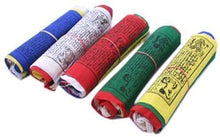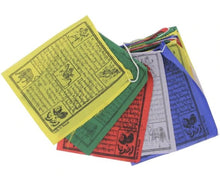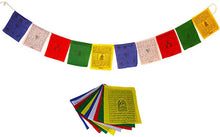The ‘Windhorse’, also known as Lung-ta in Tibetan, coupled with the “Wish Fulfilling Jewel of Enlightenment” is an important symbol inscribed onto Tibetan prayer flags. Although it represents good fortune and luck, it has a much deeper meaning which says it has power that can influence events in nature and society.
Windhorse prayer flags are the most common prayer flags among Buddhists. The image of the Windhorse is drawn on the center of the prayer flag while the outside corners are guarded by the four great animals (Four Dignities): garuda (wisdom), dragon (gentle power), tiger (confidence) and snow lion (fearless joy). These guardian animals can be represented in either pictorial form or as a written word. There are also inscriptions of sutras or mantras on the flag. It is said that when the Windhorse prayer flags flap in the wind, the spiritual powers of the sacred images and scriptures spread benefiting all those in the surroundings.
Putting on Windhorse prayer flags not only raises one’s Lung-ta energy and raises good opportunities but is also considered an act of merit. Prayer flags are hung from high points such as trees, eaves, or on wooden poles.
(*details from Extravagant Yak)








